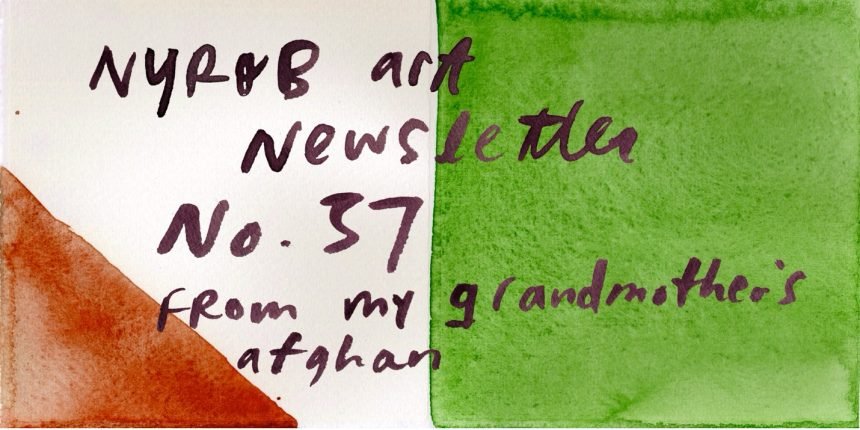When I was a kid, at bedtime my dad would tell my brother and me to go “up the wooden hill to see the blanket show.” Ever since then I have had a strong affection for blankets: I have a large blanket collection, and this is now my second newsletter involving blankets.
Due to my family’s casual adherence to primogeniture, I, two years younger than my brother, didn’t inherit much from my paternal grandmother. My brother got the good stuff. But I did get one ring and one blanket she had knit: an afghan made from scraps of wool. The colors and their random combinations make up a palette that feels like home to me; it evokes Canada in the 1940s and 1950s. I’ve had it for years and unfold it when I need ideas for color.
The London-based artist Reed Wilson made the painting on our October 9 cover: daylight filtering through the holes of a colander. Wilson paints still lifes of domestic tools—ramekins, dish towels, bottles—and when I read Leslie Chang’s essay on Chinese food and Dorothy Sue Cobble’s on domestic work, I thought of Wilson. The painting is titled Tuccia’s Colander, “after Tuccia the Vestal Virgin,” Wilson wrote to me when I asked. “[She] had to prove her ‘purity’ by carrying water in a sieve and not spilling a drop. I thought she tricked everyone by dipping the sieve in animal fat and then plunging it into cold water, which filled the holes, but I can’t find anything about that online!”
The issue starts with an essay by Verlyn Klinkenborg covering five books about octopus intelligence. I asked the ink maker Jason Logan to paint one octopus, and he painted eight. We chose a particularly beautiful one. I wanted an updated Charlotte Brontë for Frances Wilson’s review of a new biography by Graham Watson, so I asked Alain Pilon. He gave her blue eyes but changed them a few hours before the review shipped when an editor found a couple of accounts describing her eyes as “hazel.”
I’ve previously only commissioned portraits from the Norwich-based artist Maya Chessman, but after reading Chang’s thoughtful disquisition on Chinese cuisine I thought of Chessman’s illustrations of flora and fauna. She drew some wonderful hairy crabs, soybeans, mushrooms, and peppers in a basket, in the rain. John Broadley was a natural fit for Gregory Hays on three books about the Caesars. True to form, Broadley gave us a dramatic Caesar based on the Aldobrandini Tazze, a set of twelve silver standing cups that depict the lives of the Roman rulers.
The Berlin-based Romy Blümel drew Marguerite Young for David Schurman Wallace’s review of two recent reissues, of one of Young’s novels and her collected poems. Blümel was inspired by a description by Charles Ruas, from his 1977 interview with her in the Paris Review: “a colorful presence, strolling nonchalantly down Bleecker Street in her long crimson dresses, with a gold embroidered vest, her black Polish nursemaid boots worn with pink stockings, toes peeking through, and a floor-length red woolen cape thrown over her shoulder.”
The series art for the issue, titled Huellas, was by Edel Rodriguez.
The cover of the October 23 issue is a painting by the Portland-based artist Pace Taylor. I’d seen their work through Nationale, a great gallery and bookshop in Portland that also represents Carson Ellis, who drew the cover for our April 21, 2022 issue.
The painting I wanted was titled something you said. Taylor pointed out that it’s three years old, so she sent us a handful of gorgeous more recent paintings, but the editors kept coming back to the first one. I liked how it echoed Jacob Weisberg’s article about duplicity on social media and Elaine Blair’s about modern Russian feminism.
I’d seen Taryn Simon’s installation Kleroterian, a sculpture and selection of photos about elections and the madness of the 2024 American presidential campaigns, at Gagosian in March. I loved the photograph Miss Sassy, Springfield Ohio (2024), which is a portrait of the cat who had allegedly been eaten by Haitian migrants, before it was found alive and well in her owner’s basement. The photograph was an apt pairing with Weisberg’s essay on how disinformation spreads through social media algorithms.
There are so few pictures of Thomas Pynchon on- or offline. This narrowed the French illustrator Yann Kebbi’s pool of references for the portrait I commissioned to go with Andrew Katzenstein’s review of Pynchon’s new novel, Shadow Ticket. Kebbi managed, in the end, to give us a great drawing of Pynchon in his youth.
Gavin Francis’s review of two books about healing, therapists, and psychiatry made me think of Aubrey Levinthal’s pensive, sometimes melancholic work. I e-mailed her to ask if we might use her 2020 painting Bed (April), and she wrote back: “I read [Kay Redfield] Jamison’s book An Unquiet Mind, so ahead of her time to publish in 1995, I thought.”
For Christopher Tayler’s review of the Nobel Prize–winning Polish writer Olga Tokarczuk’s latest novel, The Empusium, I asked the Polish-born, London-based illustrator Maria-Ines Gul, who drew the cover of our Spring Books issue earlier this year. She gave us a bold, brushy likeness of Tokarczuk. And for Ange Mlinko’s review of two new poetry collections, by Peter Balakian and Angie Estes, I asked the LA-based illustrator Leah Reena Goren for two more of the watercolor portraits that she does so well. The issue ends with Michelle Mildenberg’s painting of the Icelandic writer Sjón for Jessi Jezewska Stevens’s review of Red Milk, his latest novel.
The series art in the issue is titled Pawned Pawns, and it’s by Gwen Smith.




















